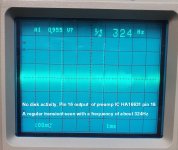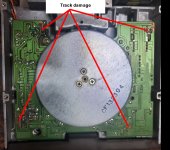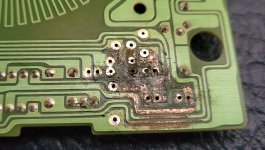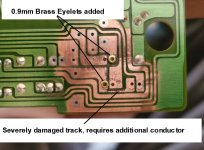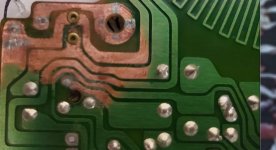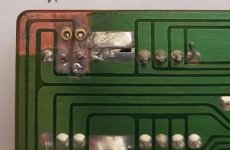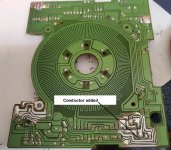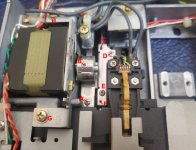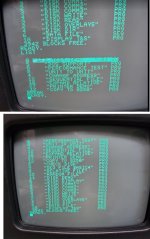Hugo Holden
Veteran Member
I have a perfectly working SFD-1001, that is to the extent that it formats and writes disks fine and there are no issues reading what it has written.
When I got the unit though I was suspicious that somebody had been working on the 5.25 drive unit in the past, because of tooling marks on some of the screw heads.
In any case I bought a SFD-1001 Demo Disk which the seller claimed was perfect and worked in the units. It did not work and the green light starts flashing red, the computer hangs and the drive makes a semi-violent buzzing sound the light then stays red and is only cleared by power cycling.
I thought it might have been bad luck, so I bought another Demo disk, exactly the same.
So I think the heads in the drive must be way off standard alignment.
The thought occurred to me that I could use the Demo disks as an alignment disk, as they must be pretty close to standard alignment if they play in other SFD 1001's (which the sellers assured me they did).
I have all the tools required and the drive's manual (doesn't have a full schematic), scope etc but I would like some advice before attempting it from somebody who has already done it, if possible. And three initial questions:
1)Since the drive wont run the demo disk, and goes it an error/lockout mode, how can I fool it into continually running the disk ?
2) Where is the best place to monitor the disk output, immediately after the head preamp ? (I don't have the full schematic yet, still looking)
3) For this unit, it looks to gain access I would have to remove the drive from its mounts and move it out of the unit, are any extension connectors required in this case ?
Thanks for any advice & help.
( also wonder if it is possible to get this sort of effect if the spindle speed is off standard ?)
I found the schematics on Zimmers:
I recorded some signals out of the head preamp. With a disk that the drive recorded there is a good 200mV pp signal out of the head preamp. With both the Demo disks it is low at only about 100mV pp and pulsing up and down a little. When the drive starts to make loud noises, some triangular patterns appear before the disk stops.
I also checked the digital output of the preamp Ic, when its playing its own disks there appears to be regular data pulse stream, with the Demo disks it just looks like noise and nothing definite.
The actual drive unit, from the look of the information I can find is the JU-570.
One other thing, it looks like somebody has applied oil to the drive, because it is appearing on the floppy disk hubs, not a huge amount but its there.
When I got the unit though I was suspicious that somebody had been working on the 5.25 drive unit in the past, because of tooling marks on some of the screw heads.
In any case I bought a SFD-1001 Demo Disk which the seller claimed was perfect and worked in the units. It did not work and the green light starts flashing red, the computer hangs and the drive makes a semi-violent buzzing sound the light then stays red and is only cleared by power cycling.
I thought it might have been bad luck, so I bought another Demo disk, exactly the same.
So I think the heads in the drive must be way off standard alignment.
The thought occurred to me that I could use the Demo disks as an alignment disk, as they must be pretty close to standard alignment if they play in other SFD 1001's (which the sellers assured me they did).
I have all the tools required and the drive's manual (doesn't have a full schematic), scope etc but I would like some advice before attempting it from somebody who has already done it, if possible. And three initial questions:
1)Since the drive wont run the demo disk, and goes it an error/lockout mode, how can I fool it into continually running the disk ?
2) Where is the best place to monitor the disk output, immediately after the head preamp ? (I don't have the full schematic yet, still looking)
3) For this unit, it looks to gain access I would have to remove the drive from its mounts and move it out of the unit, are any extension connectors required in this case ?
Thanks for any advice & help.
( also wonder if it is possible to get this sort of effect if the spindle speed is off standard ?)
I found the schematics on Zimmers:
I recorded some signals out of the head preamp. With a disk that the drive recorded there is a good 200mV pp signal out of the head preamp. With both the Demo disks it is low at only about 100mV pp and pulsing up and down a little. When the drive starts to make loud noises, some triangular patterns appear before the disk stops.
I also checked the digital output of the preamp Ic, when its playing its own disks there appears to be regular data pulse stream, with the Demo disks it just looks like noise and nothing definite.
The actual drive unit, from the look of the information I can find is the JU-570.
One other thing, it looks like somebody has applied oil to the drive, because it is appearing on the floppy disk hubs, not a huge amount but its there.
Attachments
Last edited:

